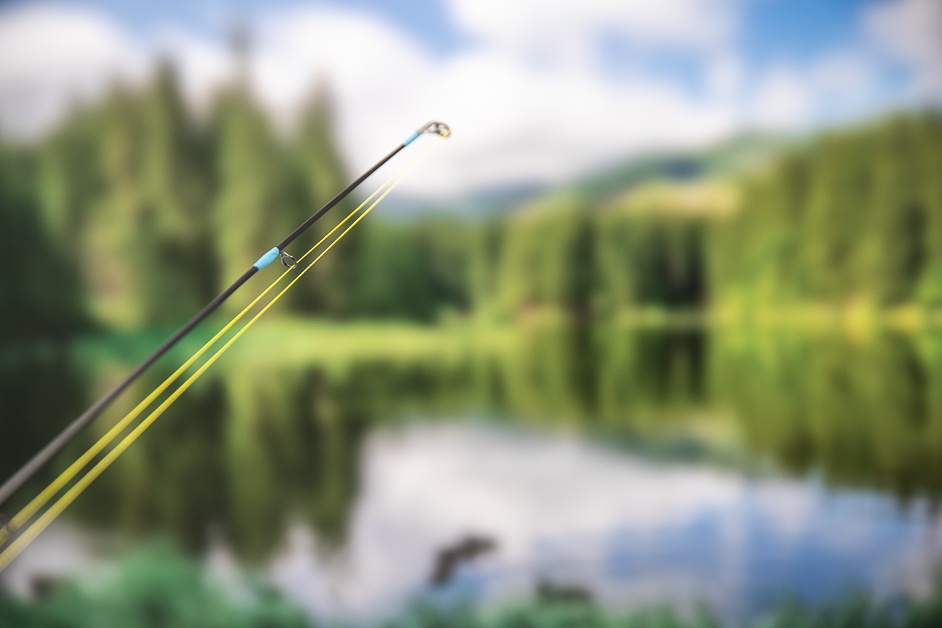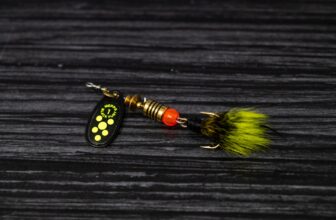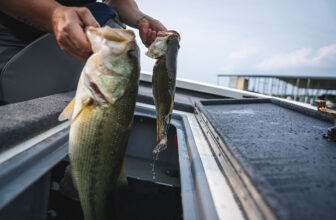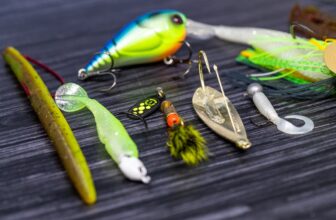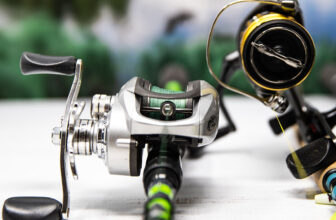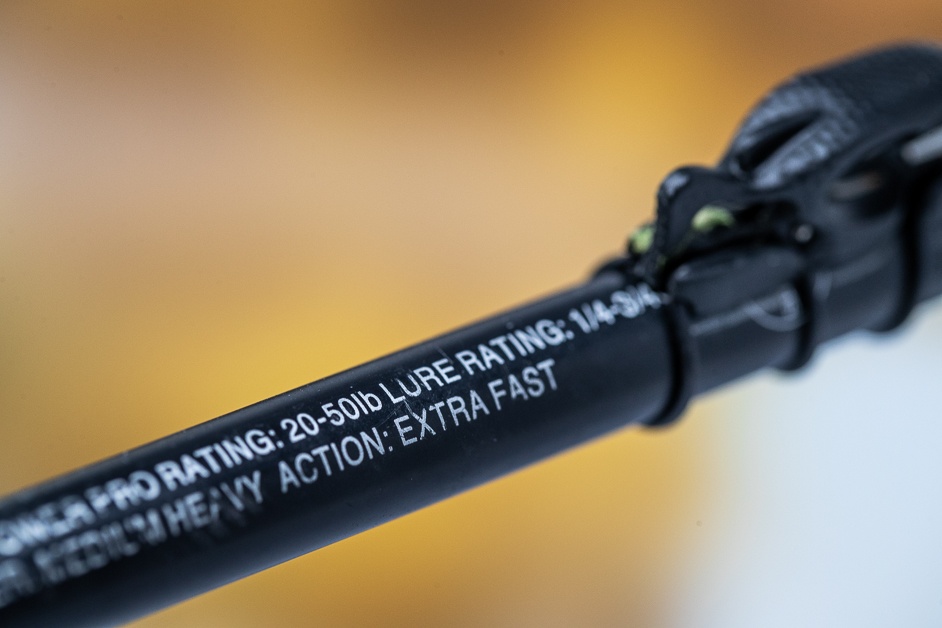
If you’re a new angler, you’re probably wondering what fishing rod action is. In simple words, action is the extent to which a rod bends when one exerts pressure on its tip. You must note that the action rating also includes the speed at which the rod resumes its natural position after bending.
The action element of a fishing rod comes together with the construction material and method type. Generally, we categorize the fishing rod action as a combination, fast, medium, or slow. In this article, we will look at all the relative details of rod action.
Fishing Rod Action – What it is
Action is a measurement of how a fishing rod will bend or deflect under pressure on its tip. Each action degree determines the maximum bending capacity of the rod. Hence:
- Fast action rod – features a bend lesser than the blank or only at the top third of the fishing rod.
- Moderate or medium rod action – features a bending capacity till the top half of the rod
- Slow Action – features a bending capacity till the rod’s lower third.
Often, when an angler is dealing with a particular type of rod, they may come across the term ‘parabolic.’ This means that the rod’s bending capacity matches its length. For instance, in the case of a fly rod with fast action, you will find it bending far more quickly than a bass rod with immediate action. The case is similar to a steelhead rod against an offshore rod too.
When working with bass rods, you will most commonly find fast or swift action. Perhaps the speedier power and better sensitivity features of the hook set are why bass rods incorporate the said action level.
When talking about faster Action, we refer to how fast the rod can shut off. Or, its bends end higher on its blank. With the fast action level, anglers do not have to struggle much to move the rod farther on the hookset just because they want it to move into the stiffer blank part.
If you’re purchasing a rod-type with fast Action, you can apply it to long casting distances and shorter ones. However, you must bear in mind that the casting distances can only work with faster Action if you’re adhering to the single hook rule, such as jig and worm fishing.
You get a bit more casting distance with sufficient hooksetting power in the medium-fast or medium-action rods. You can apply such a setting to topwater lures, crankbaits, treble hooks, spinnerbaits, and other reaction baits.
In such a situation, though, you will not feel the bite as deep as it is in a significant and single worm hook, in the case of treble hooks. Besides, this power also makes it easier for anglers to detach the hook from a strong fish. The slow power also does pull the hook out of your target’s moth until it has completely engulfed it. When you’re determining the appropriate fishing rod action to use, it is best to consider the type of lure you will use.
Taper – How it relates to Action
As you’re getting the hang of fishing concepts and terminologies, you will often find anglers associating Action with taper. Truthfully, the tape is synonymous with Action, and it refers to several things. In addition to referring to a rod’s thickness, taper also refers to the blank wall’s thickness and where the blank features more bend due to lesser material presence.
For this reason, we can consider the graphite, which the tensile module, elasticity modulus, or the carbon fibers classifies. Additionally, the farthest material stretch and the stiffness measure also classify the graphite.
If you find a higher carbon fiber modulus, you will find a lighter blank relatively for a given stiffness in it. In nature, graphite is of powerful composition, and this is why you will find the rods relatively more lightweight, more efficient, and more sensitive with a higher modulus percentage. Graphite also can use thinner walls for making the blanks.
In most situations, you will find little to no difference between fishing rod action and taper.
Action – How it Works
Like we discussed above, Action refers to how much a fishing rod deflects under pressure on its tip. This pressure can be from a fish the angler has on the end of a line or when he/she is casting.
In summary, the action power works in the following:
- Only the tip bends in extra fast
- 1/3 to ¼ upper bending in fast Action
- Last half bending in moderate Action
- Lower 1.3 bending in mild fast Action
- Complete bending into the handle in slow Action
Fishing rod action and fishing rod power are two different variables to look at on your rod. Check out the infographic below for more info on the difference between the two!
How to Choose the Right Fishing Rod Action
When you’re choosing the right fishing rod for your personal use, you have to take several factors into account, including rod action. You will commonly find the experienced anglers possessing more than one fishing rod at a time for the very reason to match various conditions, lures, and species.
Perhaps the analogy that fishing rods are like golf clubs seems apt here. Each rod has a specific purpose of serving, and we cannot expect one rod to perform all the fishing-related actions.
Hence, when you’re out hunting for the perfect fishing rods for yourself, here is how you can choose the appropriate action power. First, you must firmly remember that the Action is where a particular rod bends when you apply pressure to it. The most common action ratings include slow, moderate or medium, and fast.
These main action ratings further branch out into moderate fast, medium-fast, extra fast, and others. These different names refer to the various places where rods bend and what benefits each type offers.
Like we just discussed, each of the actions you will come across refers to a particular fishing type they excel at. In most cases, though, the fast action varieties will offer better lures and better sensitivity, critical for bottom contact.
If your main aim is to find a fishing rod that helps your retrieve lures better and fight fish, then moderate actions would better suit you. These bend farther down the road to create a more significant arc for the reasons we highlighted.
If you’re looking to move baits, like crankbaits, for example, you will find the moderate action rods quite perfect. Even for the fast-moving lures, you will find the moderate Action quite feasible. They may not have excellent sensitivity, but they do achieve better casting distances. This is only because the bending power helps you catapult the lures even better and farther.
Now let’s say you’re fishing for trout or panfish. In that case, the slow fishing rod action would suit your perfectly. The slow action power means you can cast way ahead in your rod blank and use even lighter lines for casting lighter lures.
A fishing rod featuring a faster tip means greater flexibility in the rod tip, but the rod’s rest is quite stiff. Hence, you should find flexibility at the 1/3rd to 1.4th measurement of your rod, while the rest of it should be rigid and unbending. It would be best if you remembered that the flexibility level is the rod’s action, and it determines how much control you will have over your targets in the water.
In all of this, you can note how the type of fishing projects you have in mind determines the level of action that would work best in a particular fishing rod. As the saying goes, “no one size fits all,” and in this case, no one-rod action fits all fishing types.
Slow Action vs. Fast Action Rods
If you’re looking for more forgiving rods, then slow action varieties will give you that. They also sport a lower tendency of throwing live bait from your hook. On the other hand, you will find fast action rods more sensitive comparatively.
While slow action and fast action roads both have their unique characteristics, the latter is better at letting the angler know whether their lure has reached the bottom. It does so but filling the lure with vibrations, which is a signal for the angler that their lure has reached the bottom. Fast action rods also exert more force while you’re throwing and give longer casts resultantly.
But if we talk about the slow action rods, they mainly feature a soft cast, and it is unlike its counterpart in the regard that it does not break off the bait. You would do well to choose a slow-action rod if you are using a lighter fishing line. This will also help you to cast a large lure or bait amount.
Final Thoughts
When we talk about fishing rod action, we refer to how fast it takes for a rod’s blank to return to its neutral position after bearing a load. If you have a fast blank, you must note that it will not have a very wide flex from its resting place.
Once you release the load, the blank does not take long to return to its normal position. On the other hand, the slow Action or slow blank only flexes in the top ¾ of the blank. We describe the flex capacity in terms of fast, extra fast, quiet and moderate actions. These refer to the relative time your rod needs in returning to its resting position.
When an angler understands the blank Action, he/she is better able to use the blank’s properties to enhance their fishing experience.

